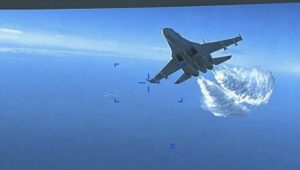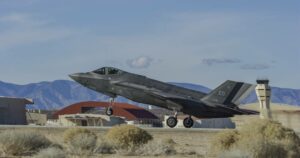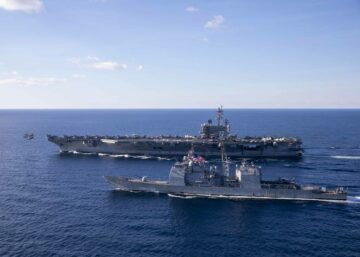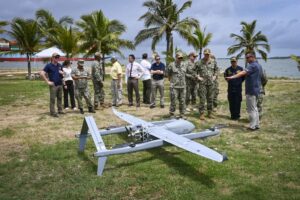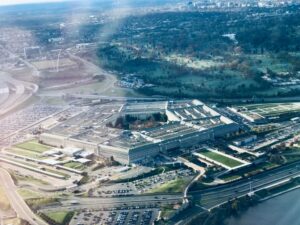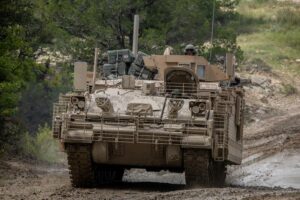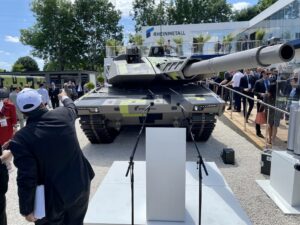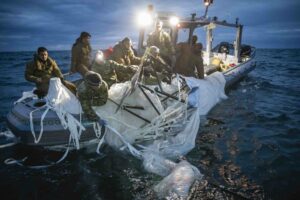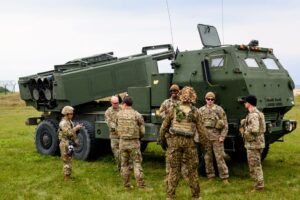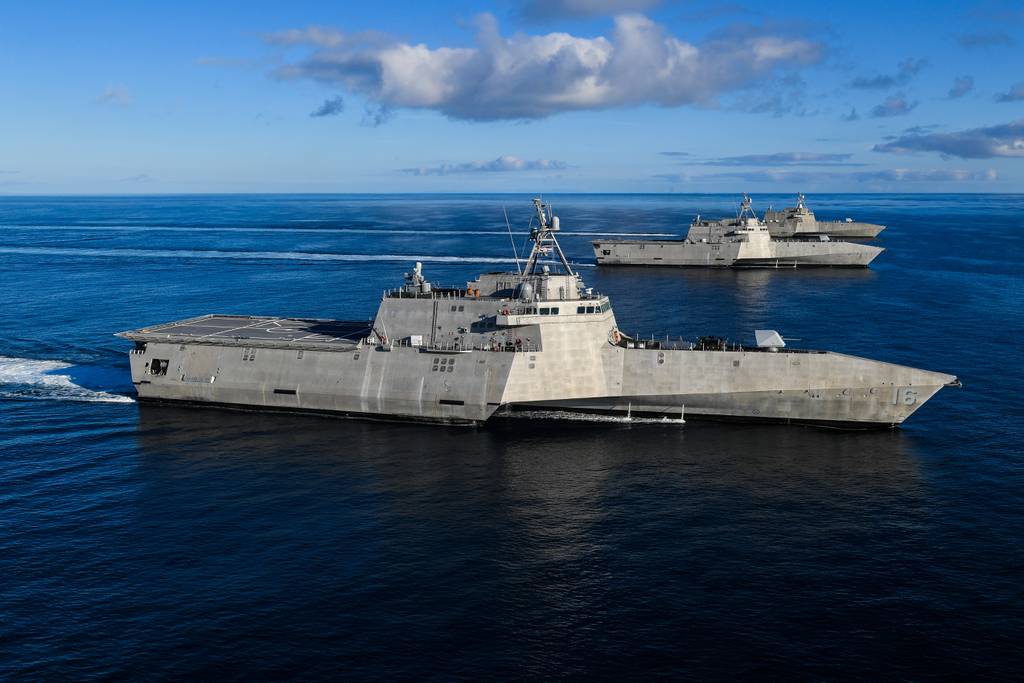
WASHINGTON — The U.S. Navy’s recent force structure study puts even greater importance on small combatants, the director of surface warfare said, a shift in priorities that could require the surface navy to rebalance its ongoing modernization plans.
“We want to build a lot of frigates and [have] somewhat smaller, very capable ships being proliferated out through the fleet,” Rear Adm. Fred Pyle told Defense News on Dec. 7.
The 2023 Battle Force Ship Assessment and Requirement study, which concluded in June but remains classified, did not bring “significant changes” to Pyle’s portfolio at OPNAV N96. However, it did shift the balance among large, small and unmanned combatants.
Asked whether the study called for more frigates generally, or more frigates at the expense of larger Arleigh Burke-class destroyers, Pyle said only that the Navy has “that constant challenge of trying to balance” the portfolio to fit the budget. His main takeaway from the new force structure assessment, Pyle added, is “the value of having numbers for small surface combatants.”
Navy spokesman David Clark told Defense News the study called for a 381-ship fleet — up from the previous call for 373 vessels — and “reinforces the need for a larger, more capable, more distributed naval force.”
Pyle said the Constellation-class frigate, for which construction began in August 2022, can help distribute the force by offering a capability similar to the Arleigh Burke destroyers but in a smaller, less expensive package.
For now, Pyle’s directorate is focused on keeping the frigate program fully funded so the Navy and Fincantieri’s Marinette Marine shipyard can finish the design and construction.
“Eventually we’d like to get to four frigates a year, and that will take a second yard,” Pyle said, without providing a timeline for ramping up production.
Although Navy leaders have long talked about wanting to build four a year to support a larger small combatant fleet — as the recent study emphasized — the Navy’s most recent long-range shipbuilding plan never reaches that rate. Leaders have said they want to see Fincantieri mature the design and production line before a second shipbuilder joins the program.
Pyle said the Navy and Pentagon are still finalizing what the force structure study means for the budget and ongoing modernization plans, and that more details would be released with the fiscal 2025 budget request around February.
Fielding new ships
Pyle said he views the surface force modernization plan in three Future Years Defense Programs — or five-year budgetary planning windows for the Pentagon.
The first Future Years Defense Program, which spans the current FY24 to FY28, focuses on building the Constellation-class frigate and the Flight III Arleigh Burke destroyers, the first of which was commissioned in October.
It will also include the start of the Large Unmanned Surface Vessel program.
Pyle said three unmanned surface vessels currently deployed in the Pacific are medium prototypes. While their mission and payloads are different than the planned large USV, which will use the Aegis Combat System to remotely launch missiles on behalf of crewed ships, these medium USVs are still generating applicable lessons on hull and navigational autonomy.
But “there is still a ton of learning ahead of us on LUSV,” Pyle said, “because once you start integrating an adjunct weapons platform into the Aegis system, that is non-trivial work.”
He said integration remains his primary concern for the Large Unmanned Surface Vessel program, for which a contract is expected to be awarded in FY25.
“We have the structure; we have the expertise in place to be able to do that,” Pyle noted. “Bottom line is, we will keep those vessels within line of sight [of manned combatants], where we can maintain positive control of them, until we have a very high confidence level that we can send them over the horizon and maintain [command and control] of those platforms and do what we need to do.”
Upgrading the fleet
The second Future Years Defense Program, which runs from FY29 to FY33, aims to add capability to the surface ships already in the fleet through the DDG Mod 2.0 program and the development of the Lockheed Martin-made Integrated Combat System.
Pyle called DDG Mod 2.0 — which adds Aegis Combat System Baseline 10, the AN/SPY-6 radar and the Surface Electronic Warfare Improvement Program (SEWIP) Block 3 package to Flight IIA destroyers — the “centerpiece” of surface fleet modernization plans.
The destroyer Pinckney recently wrapped up its SEWIP installation at the General Dynamics NASSCO shipyard in San Diego, California. The vessel caught attention online for its new look, with what the shipyard dubbed “bug eyes” and Pyle called “Princess Leia buns” on the sides of the ship. (They’re formally known as sponsons, with precisely angled steel planes to enable the electronic warfare tools housed inside.)
Pinckney will go through SEWIP testing, then deploy, then return to the yard for its radar and combat system upgrades. Around FY28, after a couple more ships go through this split installation, the DDG Mod 2.0 program will begin in earnest, Pyle said, and ships will receive all three upgrades in the same yard period.
This second Future Years Defense Program, he said, kicks off a flurry of work: $17 billion over 17 years to upgrade the 25 Flight IIA ships. “We’re constantly looking at not only SEWIP installs, but SPY-6 installs, of how we can reduce that time frame and be more efficient on the install process,” including ideas such as prefabricating the sponsons before a destroyer arrives at the yard.
Pyle said this would not only reduce cost, but get the new capability to the fleet faster.
“The warfighting capability that those systems bring, we really value in the high-end fight. So that’s the sense of urgency. That’s the imperative of why we need to fully fund these installs, and then we need to smartly execute them to get the capability back out there in the fleet,” he said.
The Integrated Combat System is also scheduled for fielding in greater numbers around this time. The Navy awarded Lockheed a contract worth up to $1.1 billion over 10 years to merge the codes for the Aegis Combat System and the Ship Self-Defense System into the same combat technology. Aegis runs on large, small and unmanned surface combatants, while the Ship Self-Defense System runs on amphibious ships and aircraft carriers.
“There’s a strong business case that we’ve laid out on why this makes sense: One system is much better than multiple from a training standpoint, from a funding standpoint,” Pyle said. “The warfighting aspect is what’s most exciting from [the N96 directorate’s] perspective because it gives us the ability to pair any decision-maker, any sensor and any desired effect at machine speed.”
Pyle said Lockheed has started installing code on individual ships for testing. By the FY28 or FY29 time frame, he added, entire carrier strike groups or amphibious ready groups will deploy with the Integrated Combat System as part of the development and deployment effort. The contract’s options could extend the work through FY30.
A next-gen combatant
The third Future Years Defense Program, from FY34 to FY38, includes the DDG(X) next-generation destroyer program.
Pyle said the Navy will build as many as 30 of the Flight III Arleigh Burke-class destroyers, which would put the program at more than 100 ships total.
But, he noted, “those ships are maxed out on space, weight, power [and] cooling. If something comes along in the form of directed energy or a larger sensor that we need to fill a warfighting capability, it’s not going on the Arleigh Burke class — period. So we need to transition to a new hull form, and that is DDG(X).”
Though the Navy had repeatedly delayed the DDG(X) in the past — from FY23 to FY25 to FY28 — Pyle said the current planned FY32 start is holding steady.
Pyle’s N96 directorate is working with the service’s Program Executive Office Ships on the DDG(X) combat system and propulsion plant designs.
The Navy’s imperative in moving to the DDG(X) design is to accommodate directed-energy weapons and a larger launcher for longer-range missiles, Pyle said. But also of importance, he added, will be the ability to remain on station longer and require less help from fleet tankers and other logistics ships.
Megan Eckstein is the naval warfare reporter at Defense News. She has covered military news since 2009, with a focus on U.S. Navy and Marine Corps operations, acquisition programs and budgets. She has reported from four geographic fleets and is happiest when she’s filing stories from a ship. Megan is a University of Maryland alumna.
- SEO Powered Content & PR Distribution. Get Amplified Today.
- PlatoData.Network Vertical Generative Ai. Empower Yourself. Access Here.
- PlatoAiStream. Web3 Intelligence. Knowledge Amplified. Access Here.
- PlatoESG. Carbon, CleanTech, Energy, Environment, Solar, Waste Management. Access Here.
- PlatoHealth. Biotech and Clinical Trials Intelligence. Access Here.
- Source: https://www.defensenews.com/naval/2023/12/27/surface-navy-emphasizes-frigates-in-its-latest-modernization-plans/
- :has
- :is
- :not
- :where
- $UP
- 1
- 10
- 100
- 11
- 17
- 2018
- 2022
- 2023
- 2025
- 25
- 30
- 7
- 70
- 8
- a
- ability
- Able
- About
- accommodate
- acquisition
- add
- added
- Adds
- adjunct
- After
- ahead
- aims
- aircraft
- All
- along
- already
- also
- among
- an
- and
- any
- applicable
- ARE
- around
- Arrives
- AS
- aspect
- assessment
- At
- attention
- AUGUST
- Autonomy
- awarded
- back
- Balance
- base
- Baseline
- Battle
- BE
- because
- before
- began
- begin
- behalf
- being
- Better
- Billion
- Block
- bring
- budget
- Budgets
- build
- Building
- business
- but
- by
- california
- call
- called
- CAN
- capability
- capable
- carriers
- case
- caught
- challenge
- class
- classified
- code
- codes
- combat
- comes
- Concern
- concluded
- confidence
- constant
- constantly
- construction
- contract
- control
- Cost
- could
- Couple
- covered
- Current
- Currently
- David
- dec
- decision-maker
- Defense
- Delayed
- deploy
- deployed
- deployment
- Design
- design and production
- designs
- desired
- details
- Development
- DID
- Diego
- different
- directed
- Director
- distribute
- distributed
- do
- dubbed
- during
- dynamics
- effect
- efficient
- effort
- Electronic
- emphasized
- emphasizes
- enable
- energy
- Entire
- Even
- exciting
- execute
- executive
- Exercise
- expected
- expensive
- expertise
- extend
- Facility
- faster
- February
- fight
- Filing
- fill
- finish
- First
- Fiscal
- fit
- FLEET
- flight
- flurry
- Focus
- focused
- focuses
- For
- Force
- form
- Formally
- four
- FRAME
- from
- fully
- fund
- funded
- funding
- future
- General
- generally
- generating
- geographic
- get
- gives
- Go
- going
- greater
- Group’s
- had
- Have
- having
- he
- help
- High
- High-End
- his
- holding
- horizon
- How
- However
- HTTPS
- ideas
- if
- iii
- images
- imperative
- importance
- improvement
- in
- include
- includes
- Including
- individual
- Indoor
- inside
- install
- installation
- installing
- integrated
- Integrating
- integration
- into
- IT
- ITS
- jack
- Joins
- jpg
- june
- Keep
- keeping
- Kicks
- known
- large
- larger
- latest
- launch
- leaders
- learning
- less
- Lessons
- Level
- like
- Line
- logistics
- Long
- longer
- Look
- looking
- Lot
- machine
- Main
- maintain
- MAKES
- many
- March
- Marine
- Maryland
- mature
- means
- medium
- Megan
- Merge
- Military
- missiles
- Mission
- modernization
- more
- more efficient
- most
- moved
- moving
- much
- multiple
- Need
- never
- New
- news
- next-generation
- noted
- now
- numbers
- Oct
- october
- of
- off
- offering
- Office
- on
- once
- ONE
- ongoing
- online
- only
- Operations
- Options
- or
- Other
- out
- over
- package
- pair
- part
- past
- pentagon
- period
- perspective
- Place
- plan
- Planes
- planned
- planning
- plans
- plant
- platform
- Platforms
- plato
- Plato Data Intelligence
- PlatoData
- portfolio
- positive
- power
- precisely
- preparation
- previous
- primary
- process
- Production
- Program
- Programs
- propulsion
- prototypes
- providing
- put
- Puts
- radar
- ramping
- Rate
- Reaches
- ready
- really
- rebalance
- receive
- recent
- recently
- reduce
- released
- remain
- remains
- remotely
- REPEATEDLY
- Reported
- reporter
- request
- require
- requirement
- return
- River
- runs
- s
- Said
- same
- San
- San Diego
- scheduled
- Second
- see
- send
- sense
- Sense of Urgency
- sensor
- September
- she
- shift
- ship
- ships
- Sides
- Sight
- similar
- since
- small
- smaller
- So
- something
- somewhat
- Space
- spans
- speed
- split
- standpoint
- start
- started
- station
- steady
- steel
- Still
- Stories
- strike
- strong
- structure
- Study
- such
- support
- Surface
- system
- Systems
- Take
- test
- Testing
- than
- that
- The
- their
- Them
- then
- There.
- These
- they
- Third
- this
- those
- three
- Through
- time
- timeline
- to
- told
- Ton
- tools
- Total
- Training
- transition
- trying
- u.s.
- U.S. Navy
- university
- University of Maryland
- until
- upcoming
- upgrade
- upgrades
- urgency
- us
- use
- VAL
- value
- very
- Vessel
- vessels
- views
- want
- wanting
- was
- we
- Weapons
- weight
- What
- when
- whether
- which
- while
- why
- will
- windows
- with
- within
- without
- Work
- working
- worth
- would
- Wrapped
- X
- year
- years
- you
- zephyrnet

